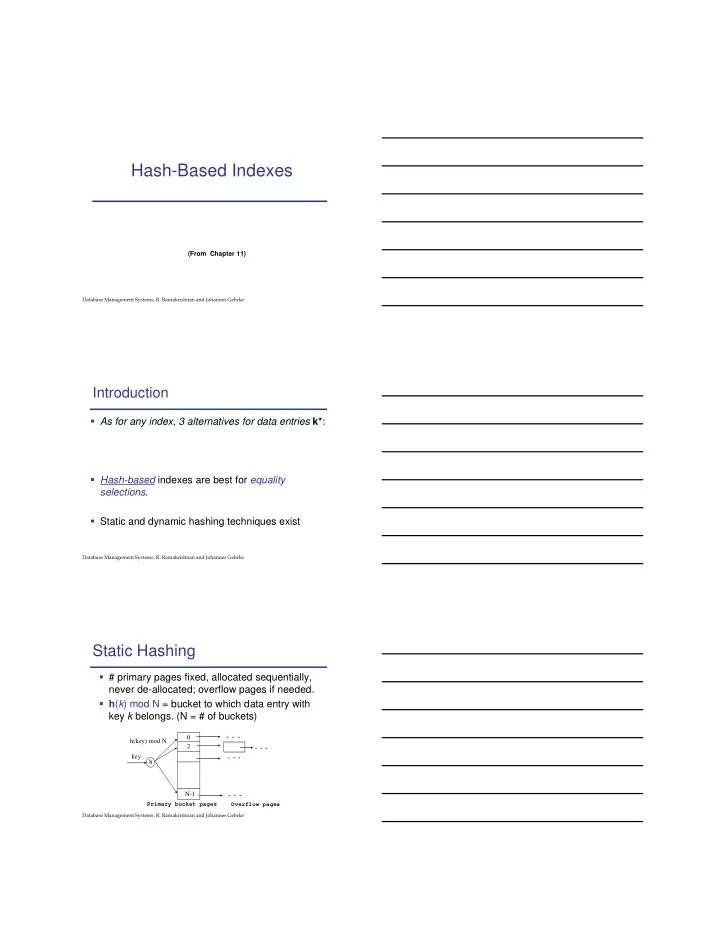

Hash-Based Indexes (From Chapter 11) �������������������������������������������� ������������������� Introduction � As for any index, 3 alternatives for data entries k* : � Hash-based indexes are best for equality selections . � Static and dynamic hashing techniques exist �������������������������������������������� ������������������� Static Hashing � # primary pages fixed, allocated sequentially, never de-allocated; overflow pages if needed. � h ( k ) mod N = bucket to which data entry with key k belongs . (N = # of buckets) 0 h(key) mod N 2 key h N-1 Primary bucket pages Overflow pages �������������������������������������������� �������������������
Static Hashing (Contd.) � Buckets contain data entries . � Hash fn works on search key field(s) of record r. Must distribute values over range 0 ... N-1. � h ( key ) = � Long overflow chains can develop and degrade performance �������������������������������������������� ������������������� Extendible Hashing � Main idea: If bucket (primary page) becomes full, why not re-organize file by doubling # of buckets? � But reading and writing all buckets is expensive! � Idea: �������������������������������������������� ������������������� Insert h (r)=14 2 LOCAL DEPTH Bucket A 4* 12* 32*16* GLOBAL DEPTH 2 2 Bucket B 00 1* 5* 21*13* 01 2 10 Bucket C 10* 11 2 DIRECTORY Bucket D 15* 7* 19* �������������������������������������������� �������������������
Insert h (r)=20 2 LOCAL DEPTH Bucket A 32* 16* 4* 12* GLOBAL DEPTH 2 2 Bucket B 00 1* 5* 21*13* 01 10 2 Bucket C 11 10* 2 DIRECTORY Bucket D 15* 7* 19* �������������������������������������������� ������������������� Insert h (r)=20 2 LOCAL DEPTH Bucket A 32* 16* GLOBAL DEPTH 2 2 Bucket B 00 1* 5* 21*13* 01 2 10 Bucket C 10* 11 2 DIRECTORY Bucket D 15* 7* 19* 2 Bucket A2 4* 12* 20* (`split image' of Bucket A) �������������������������������������������� ������������������� Insert h (r)=32 LOCAL DEPTH GLOBAL DEPTH 0 0 Bucket A 1*10* 4* 12* DIRECTORY �������������������������������������������� �������������������
Insert h (r)=16 LOCAL DEPTH GLOBAL DEPTH 1 Bucket A 1 4* 12* 10* 32* 0 1 1 Bucket B 1* DIRECTORY �������������������������������������������� ������������������� Insert h (r)=20 2 LOCAL DEPTH Bucket A 32* 16* 4* 12* GLOBAL DEPTH 1 2 Bucket B 1* 00 01 2 10 Bucket C 10* 11 DIRECTORY �������������������������������������������� ������������������� Insert h (r)=5, 15, 7, 19 3 LOCAL DEPTH 32* 16* Bucket A GLOBAL DEPTH 3 1 5* 15* 7* 000 1* Bucket B 001 2 010 10* Bucket C 011 100 101 110 111 3 DIRECTORY 4* 12* 20* Bucket A2 (`split image' of Bucket A) �������������������������������������������� �������������������
Deletions � Inverse of insertion � If removal of data entry makes bucket empty, merge with ‘split image’ � If each directory element points to same bucket as its split image, can halve directory �������������������������������������������� ������������������� Comments on Extendible Hashing � If directory fits in memory, equality search answered with _____ I/O; else _____ � 100MB file, 100 bytes/rec, 4K pages contain 1,000,000 records (as data entries) and 25,000 directory elements; chances are high that directory will fit in memory. � Directory grows in spurts, and, if the distribution of hash values is ________, directory can grow large �������������������������������������������� ������������������� Linear Hashing � This is another dynamic hashing scheme, an alternative to Extendible Hashing � LH handles the problem of long overflow chains without using a directory, and handles duplicates � Main idea: �������������������������������������������� �������������������
Inserting h(r) = 43 Level=2, N=4 h PRIMARY h 3 2 PAGES Next=0 32* 44* 36* 000 00 9* 25* 5* 001 01 14* 18*10*30* 010 10 31*35* 7* 11* 011 11 ( This info (The actual contents is for illustration of the linear hashed only!) file) �������������������������������������������� ������������������� Example (Inserting h(r) = 43) Level=2 h h OVERFLOW PRIMARY 3 2 Next=0 PAGES PAGES 32* 44* 36* 000 00 9* 25* 5* 001 01 14* 18*10*30* 010 10 31*35* 7* 11* 43* 011 11 �������������������������������������������� ������������������� Inserting h(r) = 50 (End of a Round) Level=2 PRIMARY OVERFLOW PAGES h3 h PAGES 2 32* 000 00 9* 25* 001 01 010 10 66* 18* 10* 34* Next=3 31* 35* 7* 11* 43* 011 11 100 44* 36* 00 101 5* 37*29* 01 14* 30* 22* 110 10 �������������������������������������������� �������������������
Overview of LH File � In the middle of a round. Buckets split in this round: Bucket to be split If h ( search key value ) Level Next is in this range, must use h Level+1 ( search key value ) Buckets that existed at the to decide if entry is in beginning of this round: `split image' bucket. this is the range of h Level `split image' buckets: created (through splitting of other buckets) in this round �������������������������������������������� ������������������� Summary � Hash-based indexes: best for ______ searches, cannot support _____ searches. � Static Hashing can lead to ________________. � Extendible Hashing uses directory doubling to avoid ___________ � Duplicates may require ________________ � Linear hashing avoids directory by splitting in rounds � Naturally handles ______________ � Uses overflow buckets (but not very long in practice) �������������������������������������������� �������������������
Recommend
More recommend